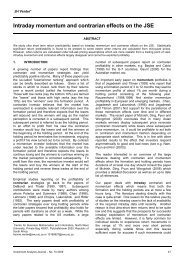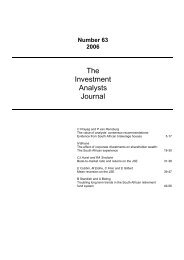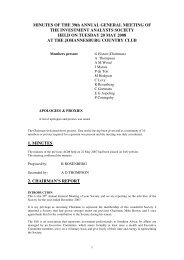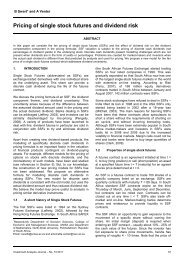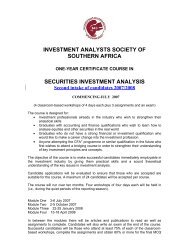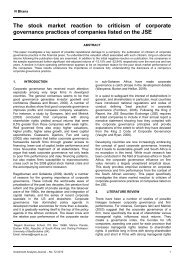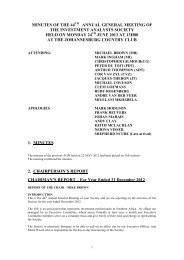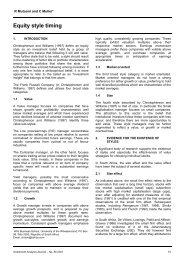Analysing some exotic options - Investment Analysts Journal
Analysing some exotic options - Investment Analysts Journal
Analysing some exotic options - Investment Analysts Journal
Create successful ePaper yourself
Turn your PDF publications into a flip-book with our unique Google optimized e-Paper software.
<strong>Analysing</strong> <strong>some</strong> <strong>exotic</strong> <strong>options</strong>: EDS, instalment shares<br />
Strike (exercise) price: K = 675<br />
Barrier level: L = 945<br />
Maturity: T =1 year (For our analysis we set time of<br />
issue as t = 0.)<br />
In this example we have K = 0,5 S(0) and<br />
L<br />
=<br />
0,7 S(0).<br />
The option is issued deep-in-the-money with<br />
immediate intrinsic value S(0) – K = 675.<br />
We have the relation<br />
C(0) = 0,5 S(0) + 0,1(0,5 S(0)) (in this example<br />
743 = 0,5(1350) + 0,1(675)), or<br />
C(0) = (S(0) − K) + 0,1(S(0) − K).<br />
The time value at issue is thus only 68. This is typical<br />
of deep-in-the-money <strong>options</strong>.<br />
Seen as an instalment share with instalments<br />
C(0) and K , we can also express the price of the<br />
option as C(0) = 0,5 S(0) + 0,1 K , i.e. the price of<br />
the EDS or first instalment is half the share price plus<br />
interest, paid upfront, of 10% on the outstanding<br />
amount K ( = 0,5 S(0)).<br />
The gearing is almost two: S(0) / C(0) ≈ 1,82. This is<br />
also the dividend gearing (see equation (4a) later on).<br />
The share price S(t) and option value C(t) then evolve<br />
over time t > 0. The gearing is maintained since<br />
deep-in-the-money <strong>options</strong> track the share price on a<br />
nearly 1–1 basis (see Section 3).<br />
If the underlying share price S(t) hits the barrier at<br />
<strong>some</strong> time t =τ, then the EDS terminates and the<br />
holder receives the intrinsic value of the option. In this<br />
case it would be S(τ) – K ≈ L – K = 0,20 S(0) = 270.<br />
There is a loss, limited to 473 cents or 64% of the<br />
premium. But note that holding the share itself would<br />
have meant a loss at t = τ of only 405 cents or a 30%<br />
loss with the investor still owning the share.<br />
If the option (EDS) is exercised at <strong>some</strong> time t, the<br />
holder will pay amount K to receive a share valued at<br />
S(t). At maturity, the option can be exercised, settled in<br />
cash to the value S(T) − K , or rolled over. In the latter<br />
case, the intrinsic value S(T) − K would have to be big<br />
enough to cover the price C*(0)of the new issue of<br />
the EDS on that particular share.<br />
Between t = 0 and time of exercise or termination of<br />
the EDS, the holder receives all dividends (if any).<br />
Possible scenarios at time t, 0 < t ≤ T , are illustrated<br />
in Table 1. We compare the cases of buying and<br />
exercising the option versus holding the share itself.<br />
As the barrier is approached, losses on the option<br />
increase. At the time of the analysis the risk-free rate<br />
was about 9%.<br />
Selling the option instead of exercising is another<br />
possibility that we consider later.<br />
If dividends with time-t value of say 50 cents are<br />
included, the option profits will increase by about 6,7%<br />
and those of the share by about 3,7%.<br />
At t =<br />
T, roll-over would be possible only if<br />
S (T) − K > 0,5 S (T) + 0,1(0,5 S (T)),<br />
assuming that an interest rate of 10% will again apply<br />
to the loan of the new second instalment. Hence rollover<br />
is possible in this case only if S(T) > 1500; in the<br />
case where rising interest rates indicate an interest<br />
rate of say 12% on the new loan we will need<br />
S(T) > 1534. Rising interest rates however can mean<br />
that share prices are slow to increase.<br />
Table 1: Profit or loss when exercising the EDS versus owning share at time t<br />
Share price<br />
(cents) at t<br />
Action taken<br />
% option profit<br />
(S(t) − K − C(0)) / C(0) × 100<br />
% share profit<br />
(S(t) − S(0)) / S(0) × 100<br />
2000 Exercise option 78,3% 48,1%<br />
1800 Exercise option 51,4% 33,3%<br />
1600 Exercise option 25% 18,5%<br />
1500 Exercise option 11% 11%<br />
1450 Exercise option 4,3% 7,4%<br />
1000 Exercise option –56% –26%<br />
945 Accept rebate –64% –30%<br />
50 <strong>Investment</strong> <strong>Analysts</strong> <strong>Journal</strong> – No. 67 2008




